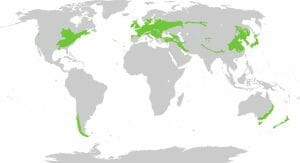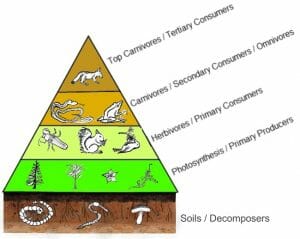Deciduous Forest Definition
A deciduous forest is a biome dominated by deciduous trees which lose their leaves seasonally. The Earth has temperate deciduous forests, and tropical and subtropical deciduous forests, also known as dry forests. Another name for these forests is broad-leaf forests because of the wide, flat leaves on the trees. Trees in tropical deciduous forests lose their leaves in the dry season and regrow them in the rainy season. In temperate deciduous forests, trees lose their leaves in the fall and regrow them in the spring.
Deciduous Forest Location
The map below shows the Earth’s deciduous forests. They are located in North America, Europe and Asia. Some famous deciduous forests include the Northeast China Plain, the Great Smoky Mountains National Park (US) and the European Temperate Deciduous Forest.

Deciduous Forest Animals
Animals inhabiting deciduous forests include insects, spiders, reptiles and birds. Mice, rabbits, foxes, deer, otters, bears and humans are just some examples of mammals that live in deciduous forests. Tropical and subtropical deciduous forests are also home to mammals such as elephants, monkeys, tigers, and giraffes.
There are several trophic (food) levels making up the food web in deciduous forests. Organisms sharing a trophic level have the same function in the food web and get their energy from the same source. The image below illustrates the organisms at each trophic level and their relationship to each other. Decomposers in the soil – such as bacteria, fungi and worms – supply nutrients for plants above to use. Plants rely on the presence of sunlight to enable them to produce energy through photosynthesis. In turn, herbivores are the primary consumers which eat the primary producers in the next trophic level. Carnivores and omnivores are secondary consumers and get energy from eating the primary consumers. Finally, the carnivores on the tertiary level feed on the creatures in the secondary level.

Deciduous Forest Plants
Deciduous forests are home to trees such as oak, birch, beech, aspen, elm and maple. Tropical and subtropical forests also have teak trees, palm trees and bamboo. Plants found in these forests include flowers, ferns, mosses and herbs. In addition, tropical and subtropical forests feature flowers such as orchids and numerous vines called lianas.
Deciduous Forest Climate
The average temperature of deciduous forests is 50°F and annual rainfall averages 30 to 60 inches. Temperate deciduous forests also have precipitation in the form of snow. Deciduous forests must have at least 120 days without frost. This period can extend to 250 days in some tropical and subtropical deciduous forests. Tropical and subtropical deciduous forests have a very tight temperature range between 68°F to 77°F. This is in stark contrast to temperate deciduous forests, which have a far wider range of -22°F to 86°F. Precipitation in temperate deciduous forests ranges 30 to 60 inches per year, while annual rainfall can be over 80 inches in tropical and subtropical deciduous forests. Recent research shows climate change is altering the way in which deciduous forests respond to temperature, precipitation and drought.
Another distinction between these two types of forests is canopy cover. Tropical and subtropical forest canopies are dense and have several layers. This prevents most of the sun’s light from reaching the forest floor. Temperate forest canopies let more light reach the forest floor, creating more plant and animal diversity.
Quiz
1. The term deciduous refers to ________________.
A. The climate in a tropical forest.
B. Trees that lose their leaves seasonally.
C. Over 80 inches of annual rainfall.
D. A dense forest canopy.
2. The primary consumer trophic level includes which of the following organisms?
A. Birds and squirrels.
B. Worms and fungi.
C. Carnivores.
D. Trees and flowers.
3. The average temperature of deciduous forests is _____.
A. 70°F
B. 50°F
C. 40°F
D. None of the above.
References
- Deciduous. (n.d.). In Merriam-Webster online. Retrieved from https://www.merriam-webster.com/dictionary/deciduous.
- Deciduous forest. (n.d.). In Encyclopedia Britannica online. Retrieved from https://www.britannica.com/science/deciduous-forest.
- “Deciduous forest.” (2017, May 8). Retrieved from http://www.conserve-energy-future.com/deciduous-forest.php.
- “Deciduous forest.” (2017, May 8). Retrieved from http://www.blueplanetbiomes.org/deciduous_forest.htm.
- Monsoon forest. (n.d.). In Encyclopedia Britannica online. Retrieved from https://www.britannica.com/science/monsoon-forest.
- “The forest biome.” (2017, May 8). Retrieved from http://www.ucmp.berkeley.edu/glossary/gloss5/biome/forests.html.
